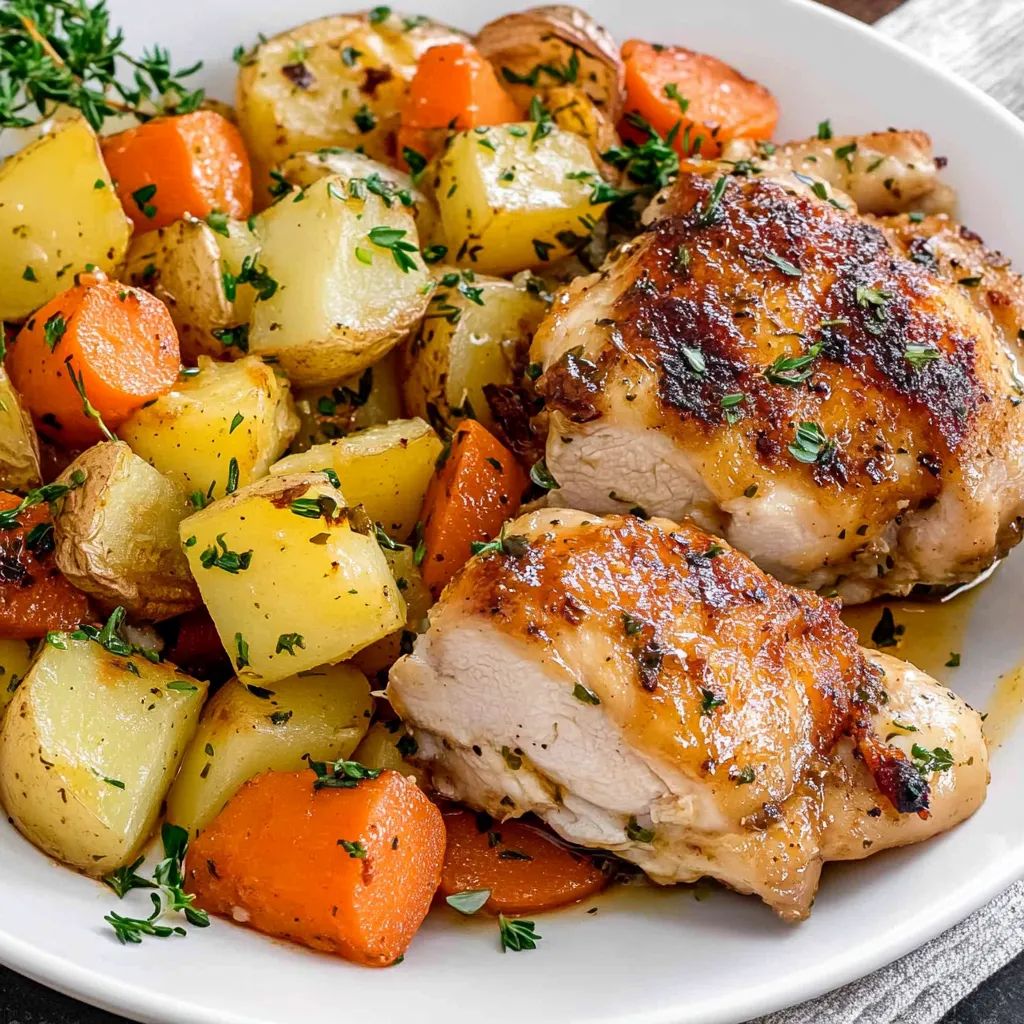 Pin it
Pin it
The irresistible harmony of sweet honey and tangy mustard transforms ordinary chicken thighs into a memorable one-pan meal that satisfies both comfort food cravings and nutritional needs. This baked honey mustard chicken with potatoes combines juicy, tender chicken with perfectly seasoned vegetables for a complete dinner that's remarkably simple to prepare. The beauty of this dish lies in its effortless elegance—minimal prep work yields maximum flavor as the ingredients meld together during baking, creating a meal that feels special despite its straightforward preparation.
I discovered this recipe during a particularly hectic week when I needed something simple yet impressive for unexpected dinner guests. Not only did they request the recipe before leaving, but my husband—who typically views chicken as merely acceptable—actually suggested we add it to our regular rotation. It's now our go-to for those evenings when we want something that feels homemade without hours in the kitchen.
Ingredients That Make All The Difference
- Dijon mustard: The subtle wine undertones in Dijon create depth that regular yellow mustard simply can't match. Its refined acidity also helps tenderize the chicken beautifully.
- Boneless skinless chicken thighs: Naturally more flavorful and forgiving than breast meat, thighs remain juicy even with extended cooking times. Their higher fat content absorbs the marinade exceptionally well.
- Fresh herbs: The bright, aromatic quality of fresh thyme and parsley elevates this dish from basic to memorable. The herbs infuse the vegetables and chicken with subtle complexity that dried herbs cannot replicate.
- Yukon gold potatoes: These potatoes have the perfect balance of starch and waxy texture, allowing them to hold their shape while still becoming creamy inside during baking.
- Honey: Beyond just sweetness, honey caramelizes slightly during cooking, creating depth and wonderful sticky glaze on the chicken. Local or wildflower varieties bring subtle floral notes.
Step-by-Step Instructions
- Step 1:
- Begin by preheating your oven to 400°F (204°C). This moderate-high temperature is perfect for developing flavor through caramelization while ensuring the chicken remains tender and the vegetables cook through properly. While the oven heats, gather your ingredients and prepare a large baking dish or Dutch oven by lightly coating it with cooking spray or a thin layer of olive oil to prevent sticking.
- Step 2:
- Create your honey mustard marinade by combining Dijon mustard, honey, olive oil, freshly minced garlic, salt, freshly ground black pepper, and chopped parsley in a large bowl. Whisk these ingredients thoroughly until they form a smooth, uniform marinade. The consistency should be thick enough to coat the back of a spoon but still pourable. This balance of ingredients creates the perfect flavor foundation—tangy from the mustard, sweet from the honey, with depth from the garlic and freshness from the parsley.
- Step 3:
- Add your boneless skinless chicken thighs to the marinade bowl and use your hands or tongs to ensure each piece is completely coated on all sides. The marinade should cling to the meat, creating a flavorful coating that will bake into a delicious glaze. Cover the bowl with plastic wrap and refrigerate while you prepare the vegetables. Even this brief marination time allows the acids in the mustard to begin tenderizing the meat while the flavors penetrate the surface.
- Step 4:
- Prepare your vegetables by cutting the onion into wedges, slicing the carrots into diagonal pieces about 1/2-inch thick, and cutting the potatoes into chunks approximately 1-inch in size. The uniform size ensures even cooking, while the specific cuts maximize surface area for flavor development. Place all prepared vegetables directly into your baking dish or Dutch oven.
- Step 5:
- Season the vegetables by drizzling them with olive oil and sprinkling with salt and freshly ground black pepper. Add several fresh thyme sprigs scattered throughout the vegetable layer. Using your hands or a large spoon, toss everything together until all the vegetables are evenly coated with oil and seasonings. The oil helps conduct heat for proper roasting, while also preventing the vegetables from drying out during the extended cooking time.
- Step 6:
- Cover the baking dish with its lid or tightly with aluminum foil and place it in the preheated oven. Bake the vegetables alone for 20 minutes. This initial covered cooking period allows the denser vegetables to soften slightly before adding the chicken, ensuring everything finishes cooking at the same time. The covered environment creates steam that helps kickstart the cooking process efficiently.
- Step 7:
- After 20 minutes, carefully remove the hot baking dish from the oven and remove the lid or foil. Arrange the marinated chicken thighs in a single layer on top of the partially cooked vegetables. Pour any remaining marinade from the bowl over the chicken pieces, ensuring none of that flavorful liquid goes to waste. This layering method allows the chicken juices and marinade to drip down and flavor the vegetables as everything cooks together.
- Step 8:
- Return the now uncovered dish to the oven and continue baking for 30-45 minutes, until the chicken is completely cooked through and the vegetables are tender when pierced with a fork. The chicken should reach an internal temperature of 165°F (75°C) for food safety. The uncovered baking allows the chicken to develop a beautiful caramelized exterior while the vegetables continue cooking in the flavorful juices below.
- Step 9:
- Once fully cooked, remove the baking dish from the oven and let it rest for about 5 minutes before serving. This brief resting period allows the juices to redistribute within the meat, ensuring maximum juiciness. Sprinkle freshly chopped parsley over the entire dish just before serving to add a final burst of color and fresh flavor that contrasts beautifully with the rich, cooked elements.
 Pin it
Pin it
I learned the importance of cooking the vegetables first through painful trial and error. My initial attempts at true one-pan cooking left me with perfectly cooked chicken but potatoes that were still too firm in the center. The two-stage cooking method was my "aha moment"—it maintains the convenience of one-pan preparation while ensuring everything reaches perfect doneness simultaneously.
Make It Your Own
This versatile recipe welcomes thoughtful variations based on your preferences and what's in your pantry. For a hint of sweetness that complements the honey, add chunks of apple or halved fresh figs during the last 15 minutes of cooking. To increase the vegetable content, bell peppers or Brussels sprouts make excellent additions. For those who enjoy more complex flavors, add a tablespoon of whole grain mustard alongside the Dijon for interesting texture and depth.
Planning Ahead
One of this recipe's greatest strengths is its make-ahead potential. The chicken can marinate for up to 24 hours in the refrigerator, developing even more flavor. For busy weeks, prepare the entire dish up to the point of baking, cover, and refrigerate for up to two days. When ready to cook, simply allow the dish to sit at room temperature for 30 minutes before following the baking instructions, adding an extra 5-10 minutes to the cooking time to account for the chilled start.
Perfect Pairings
While this dish stands beautifully on its own as a complete meal, a few thoughtful additions can elevate it further. A simple green salad dressed with lemon vinaigrette provides refreshing contrast to the rich, warm flavors. For special occasions, a glass of buttery Chardonnay or crisp Pinot Grigio beautifully complements the honey-mustard profile. And don't forget crusty artisan bread to soak up every last bit of the delicious sauce!
I've come to treasure this recipe not just for its delicious results, but for how it's simplified evening meals without sacrificing quality or nutrition. There's something deeply satisfying about placing a beautiful, complete dinner on the table that required minimal hands-on attention. Whether serving it to guests or enjoying it as a family on a busy weeknight, this honey mustard chicken consistently delivers the perfect balance of convenience and comfort that makes home cooking worthwhile.
Frequently Asked Questions
- → Can I use chicken breasts instead of thighs?
- Yes, you can use chicken breasts, but reduce the cooking time to about 20-25 minutes after adding them to avoid drying them out.
- → Can I prepare this dish ahead of time?
- You can marinate the chicken up to 24 hours in advance and prep the vegetables earlier in the day. Combine and bake when ready to eat.
- → What sides go well with this dish?
- This is a complete meal with protein and vegetables, but a simple green salad makes a perfect light side dish.
- → Can I use sweet potatoes instead of Yukon gold?
- Sweet potatoes work great in this recipe. They may cook faster than regular potatoes, so check them a bit earlier.
- → Is there a substitute for Dijon mustard?
- Whole grain mustard works well, or use yellow mustard mixed with a dash of vinegar for a similar tangy flavor.
- → How do I know when the chicken is done?
- Chicken is done when it reaches an internal temperature of 165°F or when the juices run clear when pierced with a fork.
